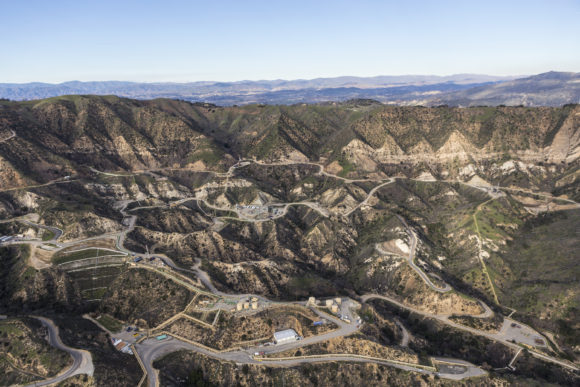About 65% of active natural gas storage (UGS) wells in the United States are located in suburban residential areas and not in more sparsely populated commercial, industrial, or even rural areas like many new unconventional wells, according to a new study published in the Journal of Environmental Health.
The study by the Center for Climate, Health, and the Global Environment (Harvard C-CHANGE) at the Harvard T.H. Chan School of Public Health provides insight into the populations at risk to UGS infrastructure and the potential health and safety impacts in the event of a well failure similar to the 2015 Aliso Canyon (California) blowout event.
The study examined the locations of 9,384 UGS wells in Pennsylvania, Ohio, West Virginia, Michigan, New York and California and the proximity of homes and residents nearby. The study’s authors say this is the first time, outside of California, researchers have looked at how many people live near similar wells.
“As the U.S. transitions more toward natural gas to meet energy needs, it is critical that we fully understand the potential health, climate and safety implications along the entire natural gas supply chain,” said Drew Michanowicz, DrPH, CPH, lead author and research fellow at Harvard C-CHANGE. “This work should help inform ongoing discussions around impacts and societal costs related to both current and future energy decisions.”
Previous population proximity studies generally relied only on census data to estimate potential populations at risk. The new method used in this Harvard study combines census block data, addresses, building footprints from satellite data, and land use data (called ABODE—Allocation By Occupied Domicile Estimate).
“From a public health perspective, this new spatial method lets us determine precisely how close people live from a potentially hazardous pollution source or other hazard” said Jonathan Buonocore, Sc.D., co-author on this study and Research Associate at Harvard C-CHANGE. “We can now provide much more accurate estimates of populations at greatest risks to discrete environmental hazards like noise and air pollution, sea level rise, and explosion hazards, among others.”
Gas storage systems pose a health risk because of hazardous air pollutants or an explosion hazard. The natural gas leak at the Aliso Canyon well failure in October 2015 was the largest single accidental release of methane in U.S. history and led to the evacuation of thousands of residents within a five-mile radius. Also, high-pressure storage of natural gas is highly flammable and can potentially expose residents to toxic compounds like benzene and formaldehyde. Long-term exposure to natural gas operations has been associated with respiratory illness, cancer and fertility issues in women.
Of the six states examined:
- Ohio exhibited the most concerning proximity between UGS wells and nearby homes. More than 50% of UGS wells in Ohio have at least one home within 650 feet and over 12,000 homes and over 30,000 residents are within 650 feet.
- The largest underestimation occurred in Pennsylvania, where ABODE found nearly 50% higher populations living within 650 feet of an active UGS well.
- In West Virginia, over half of the natural gas facilities contained at least one well that contained at least one physical residence within its setback rule (i.e., exclusion area) of 200 feet.
- Michigan exhibited the most setback conflicts of the six states assessed, but it also has the most stringent setback rule of 300 feet between wells and occupied structures of any of the states.
- New York contained the most accurate address data, but least accurate well location data. In New York, the average median offset distance was 175 feet, an inaccurate representation of actual proximity.
- In California, of the over 9,000 wells examined in the 6 states, a well in the Playa Del Rey storage field has the most nearby homes and people—150 homes and 341 people within 200 feet.
The report says two-thirds of gas storage wells across the U.S. are currently doing a job they were not designed to do, which is withstand cycles of high-pressure gas injections and withdrawals—many through a single pipe without backup safety valves to prevent blowouts (i.e., ‘Aliso Canyon-type’ wells).
These new estimates by researchers uncovered nearly 10,000 more people living within 650 feet—the distance of a city block—of a well compared to common Census-only population allocation methods.
Harvard C-CHANGE, which is led by former U.S. Environmental Protection Agency Administrator Gina McCarthy and co-director Dr. Aaron Bernstein, studies policies, technologies and products that reduce air pollution and other causes of climate change.
Source: Harvard C-CHANGE study, Population allocation at the housing unit level: estimates around underground natural gas storage wells in PA, OH, NY, WV, MI, and CA
Related:
- California Gas Leak Follows Years of Lax Regulation of Aging Storage Wells
- Estimated Cost of Southern California Gas Leak Reaches $717M
- PG&E Contains California Gas Leak That Caused Major Explosion
- Report: Dozens of Texas Gas Leak Explosions Since 2006
- U.S. Issues New Safety Rules for Underground Gas Storage Facilities
Topics California USA New York Ohio Pollution
Was this article valuable?
Here are more articles you may enjoy.



 Harvard Study Again Stirs the Pot on Demotech Ratings of Florida Carriers
Harvard Study Again Stirs the Pot on Demotech Ratings of Florida Carriers  Carnival Puts Miami Headquarters Up for Sale as Florida Real Estate Soars
Carnival Puts Miami Headquarters Up for Sale as Florida Real Estate Soars  AIG Sues Newly Launched Dellwood Insurance and Its Founders
AIG Sues Newly Launched Dellwood Insurance and Its Founders  California Chiropractor Sentenced to 54 Years for $150M Workers’ Comp Scheme
California Chiropractor Sentenced to 54 Years for $150M Workers’ Comp Scheme 

